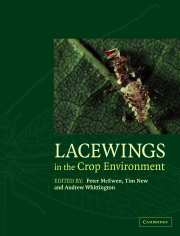Book contents
- Frontmatter
- Contents
- List of contributors
- Preface
- PART 1 Lacewing systematics and ecology
- PART 2 Lacewings in crops
- PART 3 Principles
- PART 4 Case studies
- Introduction to Part 4
- CHAPTER 18 Micromus tasmaniae: a key predator on aphids on field crops on Australasia?
- CHAPTER 19 Preliminary notes on Mallada signatus (Chrysopidae) as a predator in field crops in Australia
- CHAPTER 20 An evaluation of lacewing releases in North America
- CHAPTER 21 Chrysoperla externa and Ceraeochrysa spp.: potential for biological control in the New World tropics and subtropics
- CHAPTER 22 Comparative plant substrate specificity of Iberian Hemerobiidae, Coniopterygidae, and Chrysopidae
- CHAPTER 23 Lacewings in Sardinian olive groves
- CHAPTER 24 Lacewing occurrence in the agricultural landscape of Pianura Padana
- CHAPTER 25 Lacewings and snake-flies in Piedmont vineyards (northwestern Italy)
- CHAPTER 26 Control of aphids by Chrysoperla carnea on strawberry in Italy
- CHAPTER 27 Artificial overwintering chambers for Chrysoperla carnea and their application in pest control
- CHAPTER 28 Lacewings in Andalusian olive orchards
- CHAPTER 29 The green lacewings of Romania, their ecological patterns and occurrence in some agricultural crops
- CHAPTER 30 Biological control with Chrysoperla lucasina against Aphis fabae on artichoke in Brittany (France)
- PART 5 Conclusion
- Taxonomic index
- General index
CHAPTER 24 - Lacewing occurrence in the agricultural landscape of Pianura Padana
Published online by Cambridge University Press: 04 May 2010
- Frontmatter
- Contents
- List of contributors
- Preface
- PART 1 Lacewing systematics and ecology
- PART 2 Lacewings in crops
- PART 3 Principles
- PART 4 Case studies
- Introduction to Part 4
- CHAPTER 18 Micromus tasmaniae: a key predator on aphids on field crops on Australasia?
- CHAPTER 19 Preliminary notes on Mallada signatus (Chrysopidae) as a predator in field crops in Australia
- CHAPTER 20 An evaluation of lacewing releases in North America
- CHAPTER 21 Chrysoperla externa and Ceraeochrysa spp.: potential for biological control in the New World tropics and subtropics
- CHAPTER 22 Comparative plant substrate specificity of Iberian Hemerobiidae, Coniopterygidae, and Chrysopidae
- CHAPTER 23 Lacewings in Sardinian olive groves
- CHAPTER 24 Lacewing occurrence in the agricultural landscape of Pianura Padana
- CHAPTER 25 Lacewings and snake-flies in Piedmont vineyards (northwestern Italy)
- CHAPTER 26 Control of aphids by Chrysoperla carnea on strawberry in Italy
- CHAPTER 27 Artificial overwintering chambers for Chrysoperla carnea and their application in pest control
- CHAPTER 28 Lacewings in Andalusian olive orchards
- CHAPTER 29 The green lacewings of Romania, their ecological patterns and occurrence in some agricultural crops
- CHAPTER 30 Biological control with Chrysoperla lucasina against Aphis fabae on artichoke in Brittany (France)
- PART 5 Conclusion
- Taxonomic index
- General index
Summary
INTRODUCTION
Techniques of manipulation of agroecosystems have an important role among the strategies of integrated pest management (IPM) (van den Bosch & Telford, 1964) and its successive developments, i.e. vegetational management (Altieri& Letourneau, 1982) or ecosystem management (Speight, 1983). This technique is a complex agronomic practice leading to diversification of the agroecosystem which creates a less suitable environment for the development of the phytophagous populations (Delucchi, 1997). In this context the natural enemies are augmented either by removing and mitigating adverse elements or by providing lacking requisites (DeBach, 1974).
It appears evident that to reach these aims more must be known about the ecology of the various guilds of useful, harmful, and innocuous insects or at least about the main species. Such knowledge must necessarily concern not only crops, but also all the surrounding territory in relation to it. Numerous species, in fact, spend only a part of their life in cultivated fields needing other habitats for activities such as nesting, reproduction, overwintering, or for simple refuge (Maini, 1995).
In relation to chrysopids and other lacewings, attention has been directed for years more towards the field release of artificially reared individuals (augmentation method) than towards the above aspects. Ridgway & Kinzer (1974) and Ridgway & Murphy (1984), reviewing the use of lacewings in biological control, only once mention environmental manipulations speaking almost exclusively about the food attractants. These techniques are now well developed but their results depend on the natural populations in neighbouring areas, and on which more information is also needed.
- Type
- Chapter
- Information
- Lacewings in the Crop Environment , pp. 447 - 470Publisher: Cambridge University PressPrint publication year: 2001
- 1
- Cited by



